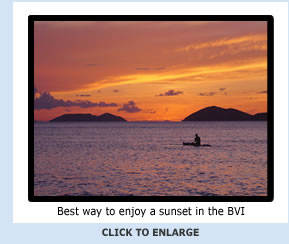 The
BVI is paddleboarder heaven. The temperature of the translucent aquamarine
sea seldom falls below eighty degrees F.. The islands are set so
close together they invite amphibious island hopping. Instead of
being stacked north to south like the rest of the Caribbean island
chain—and
thus vulnerable to the easterly trade winds—the BVI extends
east to west. There is almost always a lee for weary paddlers.
The
BVI is paddleboarder heaven. The temperature of the translucent aquamarine
sea seldom falls below eighty degrees F.. The islands are set so
close together they invite amphibious island hopping. Instead of
being stacked north to south like the rest of the Caribbean island
chain—and
thus vulnerable to the easterly trade winds—the BVI extends
east to west. There is almost always a lee for weary paddlers.
Unless your paddleboard folds in half,
it probably can’t
be put on a plane. You can truck it overland, then ship via Tropical
Shipping from Miami to Tortola It may take a while for your board
to arrive in the BVI. West Indian cargo vessels seem to specialize
in procrastination. Tape proof of purchase for your board to the
OUTSIDE of your shipping crate. Be on the dock when your board
arrives. Caribbean forklifts behave like mad bulls: They won’t
hesitate to gore your paddleboard without apology. Forklifts are
not interested in insurance. Save your crate, if anything remains
of it. You will need it to ship back to Miami.
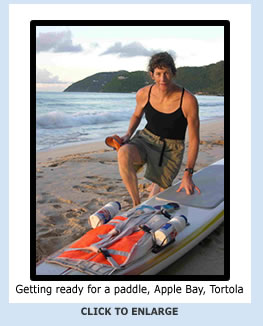 To help you plot your paddling trip though the BVI, get a nautical
chart at a chandlery in Road Town, capital of the BVI. The Tourist
Board, if in a good mood, can offer hints about where to stay.
To help you plot your paddling trip though the BVI, get a nautical
chart at a chandlery in Road Town, capital of the BVI. The Tourist
Board, if in a good mood, can offer hints about where to stay.
Before starting your tour, check your equipment.
You should be able to dryly carry a change of clothes, necessary
prescriptions, cosmetics, your passport, credit card, and a little
cash. Helpful—if
not essential—are a VHF radio, cell phone, compass, handheld
GPS and EPIRB. You never know when the wind and current will have
its way with you.
If you choose to touch all BV Islands,
as I did in ’99 (a
trip of over 200 miles), you should start paddling in Anegada,
the north most BV Island. By paddling west you will take advantage
of the consistent east wind Theoretically, you can bring your board
by ferry from Tortola to Virgin Gorda, and then go on to Anegada.
But ferry schedules from Virgin Gorda to Anegada are unobvious.
Sometimes the ferries don’t exist.
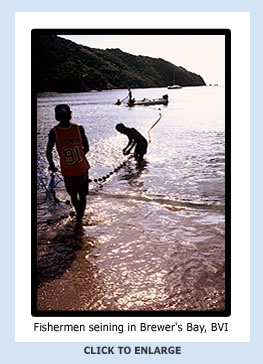
There are fifteen open ocean miles between
Anegada and your first destination to the west, Virgin Gorda.
Strong current and large waves often rule the shallow channel.
Watch you don’t run
aground on coral heads. Be sure you are a strong ocean paddler
before you start out.
When you reach Leverick Bay on VG’s east end, you can take
time to visit out islands. Close by is Necker Island, owned by
billionaire Richard Branson. He will gladly rent you his island
for $15,000/day. Best to touch Necker Island and paddle away before
annoying Branson’s security system.
Many idyllic islets hug VG’s north coast: George Dog, Great
Dog, West Dog, and Cockroach. Don’t get hypnotized by the
beauty of these pure specks of coral set in their vault of Caribbean
blue. You don’t want to get run over by one of the ferries
that dash between Tortola and VG.
On your way down VG’s north coast, visit The Baths: sparkling
tide pools full of tourists and guarded by giant granite boulders.
From VG’s east end, you cross the sapphire half-mile channel
between VG and Fallen Jerusalem, a desert isle where naturally
pink granite boulders contrast with silver sand.
From Fallen Jerusalem, skim the north rim of the Sir Francis Drake
channel (the ribbon of water between you and Tortola). You will
pass granite boulders strung like beads on a thread of shallow
turquoise sea. Then you will see, about a mile equidistant from
one another, Round Rock, Salt Cay, Dead Chest, Peter and Norman
Islands. They are small, but imposing due to tall cliffs. Turbulence
and swell between islands in a strong wind or change of tide can
be hazardous.
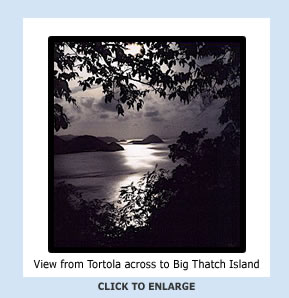 Stay on Peter Island for $1000/night or
paddle south to Norman Island. You can sleep on the floor of
the Willy T, a restaurant-vessel permanently anchored offshore.
Naked revelers who step over you on their way to the Willy T’s top deck where they plunge
screaming into the sea will ruin your sleep. Women get a Willy
T-shirt for a naked leap. Don’t count on getting a t-shirt,
ladies.
Stay on Peter Island for $1000/night or
paddle south to Norman Island. You can sleep on the floor of
the Willy T, a restaurant-vessel permanently anchored offshore.
Naked revelers who step over you on their way to the Willy T’s top deck where they plunge
screaming into the sea will ruin your sleep. Women get a Willy
T-shirt for a naked leap. Don’t count on getting a t-shirt,
ladies.
From the Willy T, paddle eight miles across
the Drake Channel to reach the west end of Tortola. Watch the
boat traffic in the Drake Channel! When you reach Tortola, stay
at the Jolly Roger Inn and listen to Reggae or local music called
Fungi. Big and Little Thatch islands are just a half mile from
the Jolly Roger. Little Thatch is gaudily occupied by an expensive
resort. Big Thatch’s
only inhabitants are thorny cactus, beaches free of human footprints
and wild cattle; the cattle can be aggressive.
To reach the extreme western BVI, cross
the four-mile channel between Tortola and Jost Van Dyke (named
after a pirate). Again, watch for boat traffic! Stay in White
Bay at Ivan Chinnery’s
Stress Free Bar and Campground. Accommodations are draughty. If
you are able to sleep on the cots, you may have been an Indian
fakir who enjoyed sleeping on a bed of nails in a previous lifetime.
Jost’s neighbors to the west, Big and Little Tobago, (not
to be confused with Trinidad & Tobago, a Caribbean country
south of the BVI), are sheer dark rocks that trail skirts of white
foam into the blue Atlantic to the north. To reach the Tobagos,
paddle west from Jost. Though not wide, the channels between Jost
Van Dyke and the Tobagos can have big water and high winds. It
is a twelve-mile round trip from Ivan’s campground to Big
Tobago. Six miles are often paddled upwind in twenty knot headwinds.
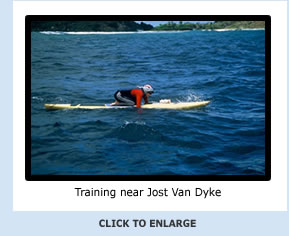 Sandy Spit, Little Jost Van Dyke and Green Cay are just a few
miles northeast of Jost. Sandy Spit, a rim of white sand surrounded
by a bustling navy of anchored pleasure vessels, is obvious from
a distance. Paddle north from the Spit and tag Little Jost Van
Dyke, a haven for little more than wild birds and feral goats.
Nearby Green Cay, once a Rockefeller protectorate is a nature preserve.
But it can be hard these days, amid the footprints and bodies of
other tourists, to perceive the form of the natural world. Sandy Spit, Little Jost Van Dyke and Green Cay are just a few
miles northeast of Jost. Sandy Spit, a rim of white sand surrounded
by a bustling navy of anchored pleasure vessels, is obvious from
a distance. Paddle north from the Spit and tag Little Jost Van
Dyke, a haven for little more than wild birds and feral goats.
Nearby Green Cay, once a Rockefeller protectorate is a nature preserve.
But it can be hard these days, amid the footprints and bodies of
other tourists, to perceive the form of the natural world.
Now you must spend time on Tortola, capital
of the BVI. Paddle four miles south (difficult in a strong northeast
wind) across the channel from Green Cay. You will arrive at a
tourist-friendly spot called Apple Bay (my home) that boasts
the BVI’s most
venerable and comfortable accommodation, Sebastian’s Hotel.
Or paddle four miles from Apple Bay up Tortola’s north coast
and stay at Brewer’s Bay Campground. The campground is poorly
maintained. You might find yourself counting flies instead of enjoying
spectacular Brewer’s Bay.
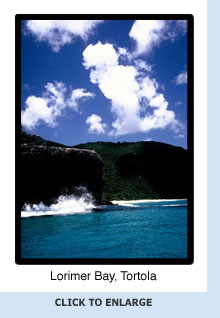 An eight-mile paddle north, usually upwind
and rough, from Brewer’s
Bay along Tortola’s north coast takes you past silvery beaches
like Lorimer Bay and Lava Flow Beach (you can’t access the
north beaches in a ground swell) to Guana Island. Like Necker,
Guana is a nature preserve, a darling of the elite, and inhospitable
to the non well heeled. If you land on Guana you will be asked
for your credentials and usually invited to leave. An eight-mile paddle north, usually upwind
and rough, from Brewer’s
Bay along Tortola’s north coast takes you past silvery beaches
like Lorimer Bay and Lava Flow Beach (you can’t access the
north beaches in a ground swell) to Guana Island. Like Necker,
Guana is a nature preserve, a darling of the elite, and inhospitable
to the non well heeled. If you land on Guana you will be asked
for your credentials and usually invited to leave.
More welcoming to the tattered adventurer
is Beef Island--where you landed when you flew in to the BVI.
Beef Island—a half-mile
east of Guana and near the airport. You can stay at the friendly
Beef Island Guest House. If you are hungry and crave e-mail, you
will find an Internet café that serves delicious food. Base
yourself on Beef Island and tour the exotic Camanoe islands to
the northeast; they have humorously named places like Throw Way
Wife Bay and Pull an’ be Damn Point.
As you paddle around the east end of Beef
Island, you will find yourself in the home stretch of your BVI
tour. It is only a hop, skip…and a paddle (ten miles) along Tortola’s south
coast to Nanny Cay, a popular hub for mariners. This is a good
spot for you to pull your paddleboard out of the water. Amid avid—and
often drunk—listeners, you can boast about paddling the BVI
and figure out what to do with your board before flying home. If you leave your board on Tortola, who
knows, maybe I’ll
buy it.
|
